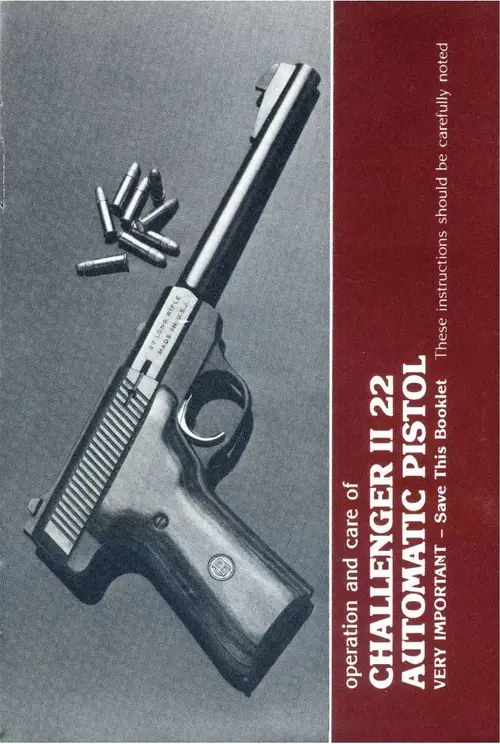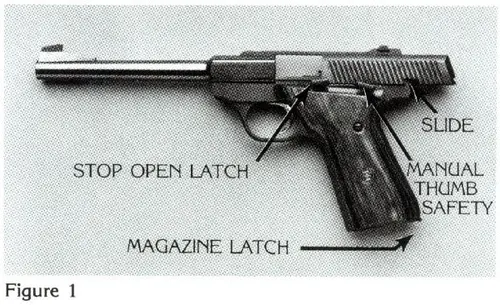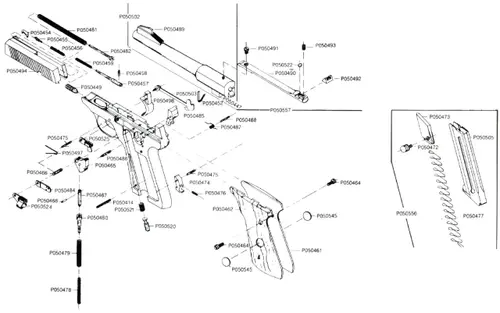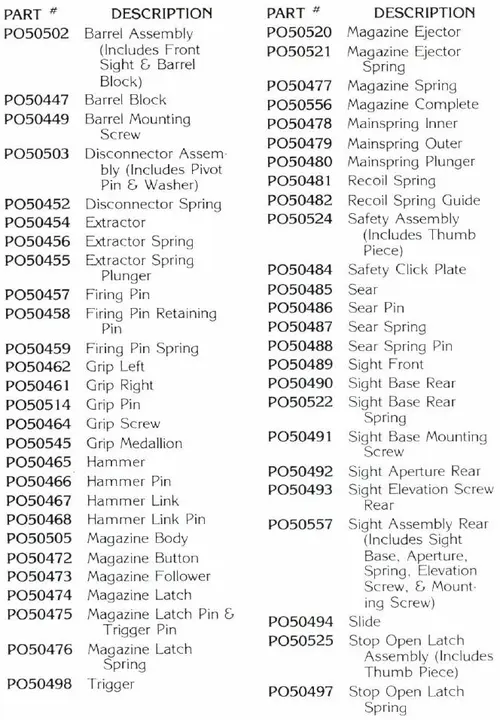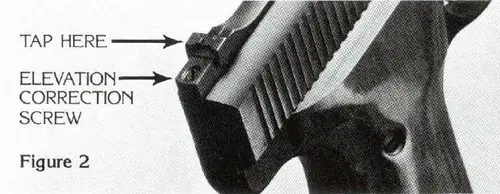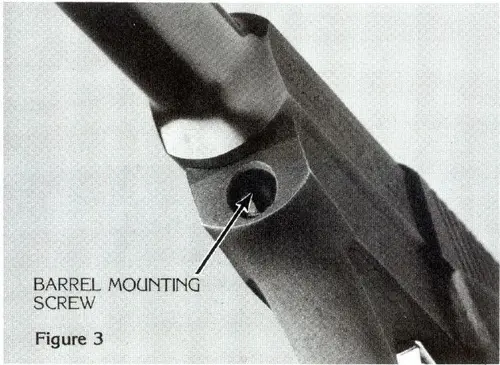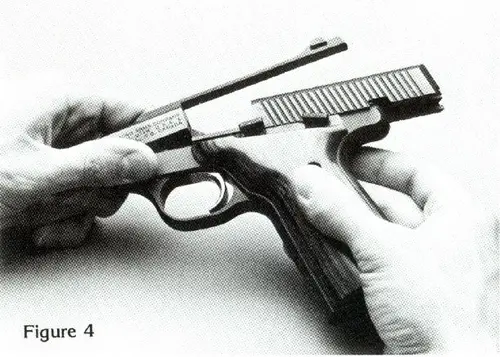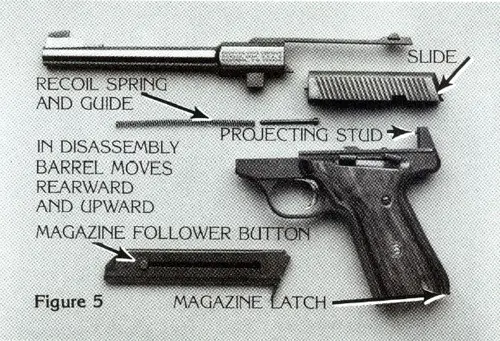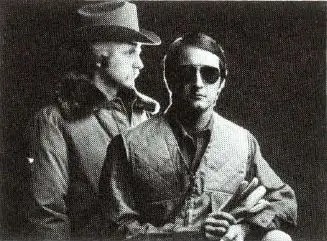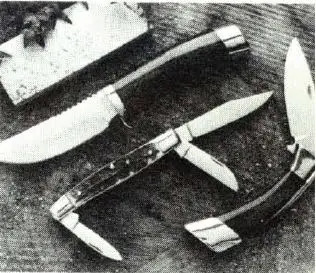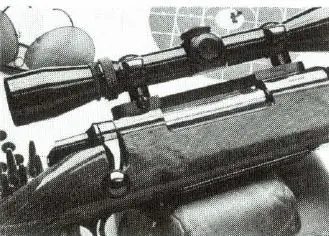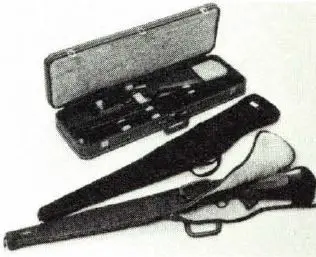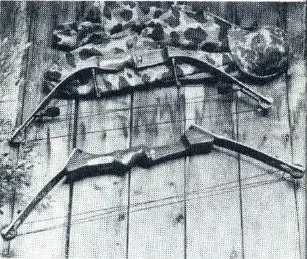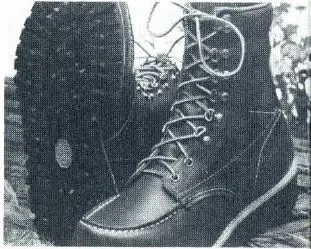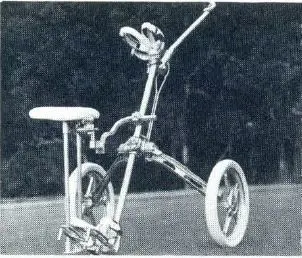Operation and care of
Challenger II 22 Automatic Pisol
Challenger II 22 Automatic Pisol
We are proud that you have chosen a Browning.
We are proud that you have chosen a Browning.
In its manufacture. we have endeavored to incorporate the very finest in materials and craftsmanship,- and with just reasonable care, this gun should provide you with many years of pleasure and dependable service. If you have any observations to make regarding its performance or appearance, we hope you will write us immediately.
Thank you.
You Are Responsible for Firearms Safety
Please let us remind you that, as a gun owner, you accept a set of responsibilities of the most demanding nature. How seriously you carry out these responsibilities can be the difference between life and death. Mistakes made with guns are final and cannot be paid for with money or regret.
PLEASE READ AND UNDERSTAND THE PROPER HANDLING AND INSTRUCTION PROCEDURES OUTLINED IN THIS BOOKLET BEFORE USING YOUR NEW FIREARM.
The cardinal rule of safe gun handling is: Always keep the muzzle of your gun pointed in a safe direction, even though you feel certain your gun is unloaded and "on safe." Be extremely alert and aware of all persons and property within the range of your ammunition. At all times handle your gun with intense respect for its force and power.
Never, under any circumstances, carry or handle your gun with a round in the chamber unless shooting is imminent. Never trust any gun's "safety." The word, "safety," is used to describe a gun's trigger block mechanism, hammer block mechanism, firing pin block mechanism, or sear block mechanism. These are all mechanical devices used to place your gun in a safer status. No guarantee can be made that the gun will not fire even if the ''safety'' is in the "on safe" position.
Like any mechanical device they can sometimes fail; they can sometimes be jarred or inadvertently manipulated into an unsafe condition. These mechanical "safeties" merely aid safe gun handling and are no excuse for pointing your muzzle in an unsafe direction.
Your responsibilities do not end when your gun is unattended. Never keep a loaded gun unattended. Store guns and ammunition in separate, locked areas. Whenever possible, store this pistol with the slide locked back and the magazine removed. (This does not harm the recoil spring in any way.) Take all safeguards to insure your gun does not become available to untrained, inexperienced or unwelcome hands.
There is no excuse for careless or abusive handling of any firearm. At all times handle your gun with intense respect for its force and power.
PLEASE READ AND PRACTICE THE FOLLOWING CAUTIONS:
CAUTION
1 - ALWAYS KEEP THE MUZZLE OF YOUR PISTOL POINTED IN A SAFE DIRECTION even though you are certain the pistol is unloaded and '' on safe.'' Never point your pistol at anything you do not intend to shoot. Be extremely alert and aware of all persons and property within range of your ammunition.
2 - NEVER TRUST YOUR PISTOL'S MECHANICAL "SAFETY" DEVICES. The word, '' safety," describes a gun's trigger block mechanism, sear block mechanism, hammer block mechanism or firing pin block mechanism. These are mechanical devices that place your gun in a SAFER status. No guarantee can be made that the gun will not fire even if the "safety" is in the "on safe" position.
Like any mechanical device a safety can sometimes fail; it can be jarred or inadvertently manipulated into an unsafe condition. Mechanical "safeties" merely aid safe gun handling and are no excuse for pointing your pistol's muzzle in an unsafe direction.
While it is a good idea to "test" your pistol's mechanical "safeties" periodically for proper function, NEVER test them with a loaded pistol or point the muzzle in an unsafe direction.
Safe gun handling does not stop with your gun's mechanical "safety" devices. It starts there. Always treat this pistol with the respect due a loaded, ready-to-fire pistol.
3 - ALWAYS REMOVE THE MAGAZINE, LOCK THE SLIDE OPEN AND VISUALLY CHECK THE CHAMBER OF YOUR PISTOL WHEN YOU PICK IT UP to be sure it does not inadvertently contain any ammunition.
4 - WHENEVER YOU HAND YOUR PISTOL TO ANOTHER PERSON always remove the magazine, lock the slide open and be sure the chamber is empty. Be sure the muzzle also points in a safe direction when handing the pistol to another person.
5 - BEWARE OF BARREL OBSTRUCTIONS. Before the first firing of your pistol clean the bore using a cleaning rod and patch. Wipe away any anti-rust compounds present in the action-chamber areas. Before you load your pistol, remove the magazine, lock open the slide, BE SURE THE CHAMBER IS EMPTY then glance through the barrel to be sure it is clear of any obstruction.
6 - DO NOT SNAP THE HAMMER ON AN EMPTY CHAMBER-THE CHAMBER MAY NOT BE EMPTY! Treat every gun with the respect due a loaded gun-even though you are certain the gun is unloaded.
7 - KEEP YOUR FINGER AWAY FROM THE TRIGGER while unloading the pistol or removing the magazine.
8 - BE SURE OF YOUR BACKSTOP. Know the range of your ammunition and be certain there is no chance of damage or accident. Never shoot at water or hard objects. Handle your pistol at all times with deep respect and alert consideration to all within its range.
9 - DO NOT CARRY YOUR PISTOL WITH A ROUND IN THE CHAMBER. We recommend you do not chamber a round until immediately before the pistol is to be fired.
10 - ALWAYS UNLOAD YOUR PISTOL WHEN NOT IN USE. Remove and unload the magazine and be sure the chamber is empty. Store your pistol and ammunition separately-beyond the reach of children. Whenever possible store this pistol with the slide locked back and the magazine removed. (This will not harm the recoil spring in any way.) Take all safeguards to keep your gun away from untrained, inexperienced, or unwelcome hands.
11 - ALWAYS UNLOAD ANY GUN'S CHAMBER AND MAGAZINE BEFORE CROSSING A FENCE, CLIMBING A TREE, JUMPING A DITCH or negotiating other obstacles. Never lean a loaded gun against a fence, tree, car or other similar object.
12 - BE SURE OF YOUR TARGET. Be sure no persons, livestock, buildings or other objects are behind or near your target. Be absolutely sure of your target, particularly during low light periods.
13 - FOR EYE AND EAR PROTECTION we recommend that you always wear shooting glasses and hearing protection when shooting.
14 - IN GRIPPING THE PISTOL, NEITHER HAND SHOULD BE IN A POSITION WHERE IT COULD BE HIT DURING THE REARWARD MOVEMENT OF THE SLIDE. You should also avoid unorthodox sighting methods where the pistol might be held close to the eye.
15 - IF YOUR PISTOL FAILS TO FIRE DUE TO A MALFUNCTION OF EITHER PISTOL OR AMMUNITION keep the muzzle pointed in a safe direction and hold this position for a minimum of 30 seconds. Carefully open the slide and remove the cartridge. If the rim is indented, it should be disposed of in a way that can not cause harm. If the rim is not indented, your pistol should be examined by a qualified gunsmith and the cause of the malfunction should be corrected before further use.
16 - BE DEFENSIVE. BE ON GUARD AGAINST UNSAFE GUN HANDLING around you and others. Don't be timid when it comes to gun safety. If you observe other shooters violating the above safety precautions, politely suggest safer handling practices.
17 - EDUCATE AND SUPERVISE. Stress firearms safety to all members of your family, especially to children and non-shooters. Closely supervise newcomers to the shooting sports. Encourage enrollment in hunting-shooting safety courses.
BE CAREFUL!
BE CAREFUL!
BROWNING CHALLENGER II 22 AUTOMATIC PISTOL NOMENCLATURE
BROWNING CHALLENGER II 22 AUTOMATIC PISTOL NOMENCLATURE
In conventional gun terminology the position and movement of pistol parts are described as they occur with the pistol horizontal and in normal firing position; i.e. the muzzle is forward or front; the pistol grip is rearward or rear; the trigger is downward or underneath; the sights are upward or on top.
NOMENCLATURE
NOMENCLATURE
In conventional firearm terminology, the position and movement of parts are described as they occur with the firearm horizontal and in the normal firing position; i.e. the muzzle is forward or front; the pistol grip is rearward or rear; the trigger is downward or underneath; the sights are upward or on top. For general nomenclature refer to Figure 1, and Figure 2 above.
AMMUNITION
AMMUNITION
Your pistol must be used only with 22 Long Rifle Cartridges. The barrel and action of this pistol have been made with substantial safety margins over the pressures developed by established commercial loads. Nevertheless, Browning can assume no responsibility for incidents that occur through the use of cartridges of non-standard dimension or those developing pressures in excess of SAAMl established standards.
GENERAL OPERATION
GENERAL OPERATION
Your new Browning is a recoil operated, semi-automatic pistol. With the chamber and magazine loaded and the safety* in the off safe or fire position, the pistol will fire a single round with each successive pull of the trigger until the magazine and chamber are empty. The slide of the pistol is designed to stay open after the last cartridge has been fired.
AMMUNITION
AMMUNITION
The Challenger II incorporates a thumb-operated sear block "safety*." To put the mechanism on safe the slide must be fully forward. The thumb safety lever is then pressed upward into the recess provided for it in the slide. (Note: This may require firm pressure. Be sure the lever travels its maximum upward movement and is completely engaged in the recess.) Although the sear is now blocked, abusive handling such as a sharp blow could still dislodge the hammer or otherwise cause the firing pin to move forward and discharge a cartridge.
When the slide is drawn rearward a Stop Open Latch can be raised to lock the slide in its open position. With a magazine in the frame, this latch is automatically actuated to lock the slide open after the last shot is fired. This is a signal the gun is empty. (Fig. 1 ).
It is important to remember that a cartridge in the chamber can be fired after the magazine has been removed so always check the chamber to be certain as to the pistol's firing status.
*See handling precautions at the beginning of this booklet.
LOADING AND FIRING
LOADING AND FIRING
At all times while loading, be certain the muzzle is pointed in a safe direction. With the slide locked to the rear and the magazine out of the gun, inspect the chamber to be sure it is empty. Close the slide and place the manual thumb "safety*'" in the "on safe'' position.
Depress the magazine's follower button (See Fig. 5, page 1 O) with the thumb of one hand. while inserting the cartridges with the other hand. Insert the loaded magazine into the pistol, being certain that the magazine is pressed completely in and is being retained by the magazine latch.
To load the chamber, move the manual thumb "safety*" lever down into the off safe position and pull the slide completely back. Release the slide. It will move forward under spring pressure and feed the first cartridge from the magazine into the chamber. THE PISTOL IS NOW READY FOR FIRING.
After pulling the trigger and thus firing the cartridge, the pistol automatically ejects the fired cartridge and feeds a fresh cartridge from the magazine into the chamber ready for a second shot. Thus the shooter may fire the pistol until the magazine is empty merely by pulling the trigger for each shot. After the last shot is fired, the Stop Open Latch automatically holds the slide in its open or rearward position.
During reloading, it is recommended that you remove the empty magazine, inspect the chamber to be sure it's empty, then close the slide and place the manual thumb "safety*" in the "on safe" position. By inserting the loaded magazine with the slide closed, there is no danger of inadvertently tripping the Stop Open Latch and feeding a live cartridge into the chamber from the loaded magazine.
Caution: You will have observed by cocking the pistol the slide moves rearward about one inch past the rear of the frame. In shooting, neither hand should be in a position where it could be hit by the slide in its rearward movement
NOR SHOULD UNORTHODOX SIGHTING METHODS BE USED WHERE THE PISTOL IS HELD CLOSE TO THE EYE.
*See handling precautions at the beginning of this page.
Schematic is provided for parts identification only and should not be used as a guide to assemble guns.
UNLOADING THE PISTOL
UNLOADING THE PISTOL
To remove the cartridge remaining in the chamber, raise the thumb "safety*" lever to its "on safe" position and withdraw the magazine from the pistol. Then move the "safety*., to the off safe position and slowly pull rearward on the slide to extract and eject the cartridge from the chamber. Inspect the action and chamber to be sure that a live cartridge does not remain in the pistol.
With the magazine removed, the Stop Open Latch must be raised manually to hold the slide open.
SIGHTS
SIGHTS
The Challenger II is equipped with a prec1s1on rear sight which is screw adjustable for elevation and drift adjustable for windage.
1. To raise the point of impact, turn the elevation screw located just behind the rear sight in a clockwise direction. To lower, turn the elevation screw in a counter-clockwise direction (Fig. 2).
2. To move the point of impact right or left, the rear sight must be moved a very slight amount in its dovetail slot. This is accomplished by lightly tapping the rear sight in its dovetail in the same direction you want the bullet impact to move. A small wood dowel or comparable non-metallic object should be used to bear against the sight during tapping to avoid marring the finish (Fig. 2).
*See handling precautions at the beginning of the page
DISASSEMBLY
DISASSEMBLY
1. Remove the magazine. Draw the slide rearward and lock open with stop open latch. Visually inspect the chamber to be certain it is empty.
2. Located under the barrel on the front of the frame is the barrel mounting screw. Loosen this screw until it becomes disengaged from the barrel (Fig. 3). It is unnecessary to remove the screw completely from the frame.
3. Slide the barrel rearward and upward to separate it from the frame (Fig. 4).
4. Release the slide and allow it to move slowly forward and off the front of the frame, being careful not to lose control of the recoil spring.
This is sufficient disassembly for all practical cleaning and lubricating required. Further disassembly is recommended only by competent gunsmiths or the Browning service facility.
DISASSEMBLY
DISASSEMBLY
The slide assembly may be cleaned with any good gun cleaning solvent or light oil and then dried with a clean cloth, or preferably blown dry with air pressure, if available.
The barrel may be cleaned with a good quality powder solvent such as Browning Liquid Gunsmith. Ordinarily, a light lubricating oil will suffice for this purpose. Use a small brush to remove dirt or other foreign matter from other parts of the action. Lubricate the pistol with a good light gun oil. All moving parts should be occasionally lubricated. Use oil sparingly; a very light film is sufficient. Browning Gun Oil is ideally suited for this purpose.
The magazine should be cleaned every 500 to 1000 rounds for best operation since a certain amount of lubricant and dirt will gradually collect in this mechanism. Place the magazine in a good gun-cleaning solvent and agitate to loosen and remove grease and dirt. While the magazine is still submerged, also pull the magazine follower back and forth a few times. Shake all excess solvent from the magazine and dry with a cloth, or preferably blow dry with air pressure, if available.
Caution: Most solvents are highly inflammable. Appropriate safety measures should be practiced when working with solvents.
REASSEMBLY
REASSEMBLY
1. Replace the recoil spring and recoil spring guide in the top of the slide.
2. Replace the slide on the guide rails of the frame and push rearward until the recessed coll.ar on the end of the recoil spring guide can be placed on the projecting stud in the rear part of the frame (Fig. 5). Then continue to push the slide as far rearward as it will go and lock in this rearward position with the stop open latch.
3. Place the barrel on the frame so that the barrel mounting screw aligns with the barrel mounting screw recess in the frame. Pull the barrel rearward against the frame and secure the barrel to the frame by tightening the barrel mounting screw.
Caution: If the barrel is not tight, you will experience accuracy and functioning problems.
SERIAL NUMBER: The serial number of your pistol can be found stamped on the front of the pistol grip portion of the frame.
SPECIFICATIONS
SPECIFICATIONS
Caliber
Capacity of Magazine
Over-all length
Length of Barrel
Height of Pistol
No. of Rifling Grooves
Twist of Rifling
Weight of Pistol
Sights
Sight Radius
22 Long Rifle
10 Cartridges
10 7/8 inches
6¾ inches
5¼ inches
6 Grooves
Right Hand
38 oz.
1/8" Wide Front; Windage and Elevation Adjustment Rear
9 1/8 inches
SERVICE OR REPAIR
SERVICE OR REPAIR
If your pistol should require service or repairs we suggest you first contact a local authorized Browning Firearms Service Center. Your Browning Sporting Goods dealer can tell you the address of the Service Center nearest you or you may call or write our Consumer Information Dept. in Morgan, Utah - (801) 876-2711.
Otherwise, you may return your pistol to our own repair facility for servicing. The address is:
Browning Service Department
Route 4, Box 624-B Tenbrook Road
Arnold, Missouri 63010 (314) 287-6800
Canadian Customers-Please call or write:
Browning Canada Sports Ltd/Ltee
5350 Ferrier Street
Montreal, Quebec H4P 1 L9
Phone: (518) 298-8130
When returning your pistol for servicing, please be sure it is unloaded, package securely in a strong cardboard container, and insure the shipment. Under no circumstances should ammunition be returned as it is against postal and commerce regulations. Send a letter to our service department clearly describing the trouble experienced and the repairs or alterations desired. If convenient, also enclose a copy of your letter with the gun.
OTHER BROWNING PRODUCTS
OTHER BROWNING PRODUCTS
BROWNING SPORTSMAN'S CLOTHING
Hunting and shooting clothing tailored for comfort, utility and style. Also hats, shooting gloves, and leather belts.
SPORTSMAN'S KNIVES
Knives to dress big game. clean fish. and handle any camp chore. Fixed blade. folding hunters. pocket knives and a fillet knife with a fine cork handle to keep it afloat. All Browning knives are crafted from specially heat treated, high-carbon. stainless steel.
BROWNING SPORTING ARMS
World famous for handcrafted quality and dependability. Browning Sporting Arms include a complete line of shotguns. high power rifles, 22 caliber rifles and pistols in high power and small bore calibers.
GUN CASES
Protect your new Browning in a choice of 3 flexible cases. They come with vinyl or canvas exteriors, soft interiors that won't scratch, and full-length zippers for easy uncasing. Fitted luggage cases are available for all Browning shotguns and rifles. They· re a must if your guns are subjected to a lot of abuse. They have a solid plywood frame with a Naugahyde® exterior and a nylon fleece interior.
GUN CARE PRODUCTS
Gun Oil cleans, lubricates, and protects metal and bluing. It's designed to function in extreme temperatures. Available in pouring spout or aerosol can. Liquid Gunsmith is a swift penetrating, hard scrubbing bore and metal cleaner that lubricates as it cleans. Comes in aerosol cans.
BROWNING FISHING TACKLE
You'll catch more fish whether you choose Browning Boron, Hi-Density Graphite, or Silaflex II Fiberglass. There's a rod to handle everything from ultralight freshwater to deep sea action. Browning is also the sole U.S. distributor of the famous line of Mitchell fishing reels.
BROWNING ARCHERY EQUIPMENT
Browning compound bows give you a select hardwood handle riser. limbs of hard rock maple and fiberglass laminations and eccentric cams mounted in limb notches rather than on bulky metal hangers for a faster, harder-hitting arrow. In addition to high-performance hunting models, there are special light draw weight models for junior and lady archers.
BROWNING BOOTS
Browning Boots are known for their comfort and long wear. They"re built from the finest leathers, with features like Vibram soles. Goodyear storm welts. Norwegian reverse welts, full glove leather linings and soft cushion insoles.
BROWNING GOLF EQUIPMENT
Whether you shoot double bogey or par, Browning ·s line of low profile clubs, distinctive bags. and tireless Bag Boy Golf Carts will make your game more enjoyable.
You Are Responsible For Firearms Safety
As a gun owner, you accept a set of demanding responsibilities. How seriously you take these responsibilities can be the difference between life and death.
THERE IS NO EXCUSE FOR CARELESS OR ABUSIVE HANDLING OF ANY FIREARM. AT ALL TIMES HANDLE YOUR HANDGUN AND ANY OTHER FIREARM WITH INTENSE RESPECT FOR ITS POWER AND POTENTIAL DANGER. PLEASE READ AND UNDERSTAND THE CAUTIONS AND PROPER HANDLING PROCEDURES OUTLINED IN THIS BOOKLET BEFORE USING YOUR NEW FIREARM.
1 - ALWAYS KEEP THE MUZZLE OF YOUR HANDGUN POINTED IN A SAFE DIRECTION. Never point any firearm at anything you do not intend to shoot. Be extremely alert and aware of all persons and property within the range of your ammunition.
2 - NEVER RELY TOTALLY ON YOUR FIREARM’S MECHANICAL “SAFETY” DEVICE. The word “safety” describes a gun’s blocking or disengaging mechanism for the trigger, sear, hammer and/or firing pin. Although mechanical devices place the pistol in a SAFER status, no guarantee can be made that the gun will not fire even if the “safety” is on the “on safe” position.
LIKE ANY MECHANICAL DEVICE, A “SAFETY” CAN SOMETIMES FAIL; IT CAN BE JARRED OR INADVERTENTLY MANIPULATED INTO AN UNSAFE CONDITION.
Mechanical “safeties” merely aid safe gun handling and are no excuse for pointing your guns muzzle in an unsafe direction. While it is a good idea to “test” your guns mechanical “safeties” periodically for proper function, NEVER TEST IT WHILE YOUR GUN IS LOADED OR POINTED IN AN UNSAFE DIRECTION.
Safe gun handling does not stop with your guns mechanical “safety” devices – it starts there. Always treat this pistol with the respect due a loaded, ready-to-fire firearm.
3 - DO NOT CARRY YOUR HANDGUN WITH A ROUND IN THE CHAMBER. For good safety practice, it is recommended that a round not be chambered until immediately before your pistol is to be fired.
4 - WHENEVER YOU HANDLE YOUR HANDGUN, OR HAND IT TO SOMEONE, MAKE SURE IT IS COMPLETELY UNLOADED. To fully unload your handgun, you must first remove the magazine, open and lock the slide rearward, and visually inspect the chamber to be certain it does not contain a cartridge. It is vital that you remove the magazine from your pistol so a cartridge is not automatically chambered when you close the action. Always keep the chamber empty and “safety” in the “on safe” position unless shooting is imminent.
5 - DO NOT TRANSPORT YOUR FIREARM LOADED. Keep it unloaded, whether stored in a holster, gun case or other container.
6 - HUNTING FROM ELEVATED SURFACES SUCH AS TREE STANDS IS DANGEROUS and may increase the risk of handling a firearm. The following rules should always be observed by you and those you hunt with: Always make certain that the stand being used is safe and stable. Always make certain that your firearm is unloaded when it is being taken up and down from the stand. Always make certain that your firearm is not dropped from the stand, or dropped while it is being taken up or down from the stand. Remember, a loaded firearm may discharge when dropped, even with the safety in the safe position.
7 - BEWARE OF BARREL OBSTRUCTIONS. When preparing to shoot your pistol, check for a barrel obstruction as follows: first, fully unload the pistol by removing the magazine, locking the action open and inspecting the chamber. BE CERTAIN NO LIVE ROUND IS IN THE CHAMBER. Then glance down the barrel to be sure it is clear of any obstruction. It takes only one small obstruction to dangerously increase pressures. Before the first firing, clean the bore with a cleaning rod and patch, and wipe away any anti-rust compounds in the chamber and around the action.
BE ALERT TO THE SIGNS OF AMMUNITION MALFUNCTION.
If you detect an off sound or light recoil when a cartridge is fired, do not load another cartridge into the chamber. Fully unload by removing the magazine and removing the cartridge from the chamber. With the action open, glance down the barrel to make sure that an obstruction does not remain in the barrel. If there is an obstruction, completely clear the barrel before loading and firing again. Failure to follow these instructions can cause extensive damage to your gun and possible serious injury to yourself and others.
8 - BE CERTAIN YOUR PISTOL IS UNLOADED BEFORE CLEANING. Because so many gun accidents occur when a firearm is being cleaned, special and extreme care should be taken to be sure your gun is unloaded before disassembly, cleaning and reassembly. Keep ammunition away from the cleaning location. Never test the mechanical function of any firearms with live ammunition.
9 - ALWAYS COMPLETELY UNLOAD YOUR PISTOL WHEN NOT IN USE. Your responsibilities do not end when your firearm is unattended. Store your pistol and ammunition separately and well beyond the reach of children. Take all safeguards to ensure your pistol does not become available to untrained, inexperienced or unwelcome hands.
10 - USE THE PROPER AMMUNTION. The barrel and action of this pistol have been made with substantial safety margins over the pressures developed by established American commercial loads.
HOWEVER, BROWNING ASSUMES NO LIABILITY FOR ACCIDENTS THAT OCCUR THROUGH THE USE OF CARTRIDGES OF NON-STANDARD DIMENSIONS OR THAT DEVELOP PRESSURES IN EXCESS OF COMMERCIALLY AVAILABLE AMMUNITION THAT HAS BEEN LOADED IN ACCORDANCE WITH STANDARDS ESTABLISHED BY THE SPORTING ARMS AND AMMUNITION MANUFACTURERS INSTITUTE (SAAMI).
EXAMINE EVERY CARTRIDGE YOU PUT IN YOUR FIREARM.
Browning cannot assume any responsibility for the use of unsafe or improper arms and ammunition combinations. It is your responsibility to read and heed all warnings in your instruction manual and on ammunition boxes.
11 - DISCHARGING FIREARMS IN POORLY VENTILATED AREAS, CLEANING FIREARMS, OR HANDLING AMMUNITION MAY RESULT IN EXPOSURE TO LEAD AND OTHER SUBSTANCES KNOWN TO CAUSE BIRTH DEFECTS, REPRODUCTIVE HARM AND OTHER SERIOUS PHYSICAL INJURY. HAVE ADEQUATE VENTILATION AT ALL TIMES, WASH HANDS THOROUGHLY AFTER EXPOSURE.
12 - DO NOT SNAP THE FIRING PIN ON AN EMPTY CHAMBER – THE CHAMBER MAY NOT BE EMPTY! Treat every gun with the respect due a loaded gun, even though you are certain the gun is unloaded.
13 - KEEP YOUR FINGERS AWAY FROM THE TRIGGER WHILE UNLOADING AND LOADING – UNTIL YOU ARE READY TO SHOOT.
14 - BE SURE OF YOUR TARGET AND BACKSTOP. Take additional care during low-light periods. Know the range of your ammunition. Never shoot at water or hard objects.
15 - DROPPING YOUR HANDGUN WHEN LOADED CAN CAUSE AN ACCIDENTAL DISCHARGE EVEN WITH THE “SAFETY” ON. Be extremely careful while hunting or during any shooting activity, to avoid dropping a loaded firearm.
16 - ALWAYS COMPLETELY UNLOAD YOUR PISTOL’S CHAMBER BEFORE CROSSING A FENCE, CLIMBING A TREE, JUMPING A DITCH OR NEGOTIATING OTHER OBSTACLES. Never place your firearm on a car, or on any unstable object.
17 - IF YOUR FIREARM FAILS TO FIRE, KEEP THE MUZZLE POINTED IN A SAFE DIRECTION. Hold this position for a minimum of 30 seconds. Carefully open the action and remove the cartridge. If the rim is indented, the cartridge should be disposed of in a way that cannot cause harm. If the rim is not indented, your firearm should be examined by a qualified gunsmith and the cause of the malfunction should be corrected before further use.
18 - WEAR EYE AND EAR PROTECTION WHEN SHOOTING. Unprotected, repeated exposure to gunfire can cause hearing damage. Wear hearing protectors (shooting ear plugs or muffs) to guard against such damage. Wear shooting glasses to protect your eyes from flying particles. Always keep a safe distance between the muzzle of your firearm and any persons nearby, as muzzle blast, debris and ejecting shells could inflict serious injury. Also, wear eye protection when disassembling and cleaning your pistol to prevent the possibility of springs, spring-tensioned parts, solvents or other agents from contacting your eyes.
19 - BE DEFENSIVE AND ON GUARD AGAINST UNSAFE GUN HANDLING AROUND YOU AND OTHERS. Don’t be timid when it comes to gun safety. If you observe other shooters violating any of these safety precautions, politely suggest safer handling practices.
20 - SUPERVISE AND TEACH FIREARMS SAFETY TO ALL MEMBERS OF YOUR FAMILY. This is especially important when children and non-shooters are involved. Closely supervise newcomers to the shooting sports. Encourage enrollment in hunting/shooting safety courses.
21 - NEVER DRINK ALCOHOLIC BEVERAGES OR TAKE ANY TYPE OF DRUGS BEFORE OR DURING SHOOTING. Your vision and judgment could be dangerously impaired, making your gun handling unsafe to you or to others.
22 - PERIODIC MAINTENANCE – AVOID UNAUTHORIZED SERVICING. Your firearm is a mechanical device that will not last forever, and as such, is subject to wear and requires periodic inspection, adjustment, and service. Like all Browning firearms, your firearm should be serviced by a Browning Recommended Service Center or by Browning’s service facility in Arnold, Missouri.
BROWNING CANNOT ASSUME ANY RESPONSIBILITY FOR INJURIES SUFFERED OR CAUSED BY UNAUTHORIZED SERVICING, ALTERATIONS OR MODIFICATIONS OF BROWNING FIREARMS.
Read and heed all warnings in your owner’s manual, on ammunition boxes and with all accessories that you install on your firearm. It is your responsibility to secure the most up-to-date information on the safe handling procedures for your Browning gun. Browning assumes no liability for incidents which occur when unsafe or improper gun accessories or ammunition combinations are used.
Do not, under any circumstance, alter the trigger, safety or parts of the firing mechanism of this or any other firearm. Failure to obey this warning may result in injury or death to yourself or others.



